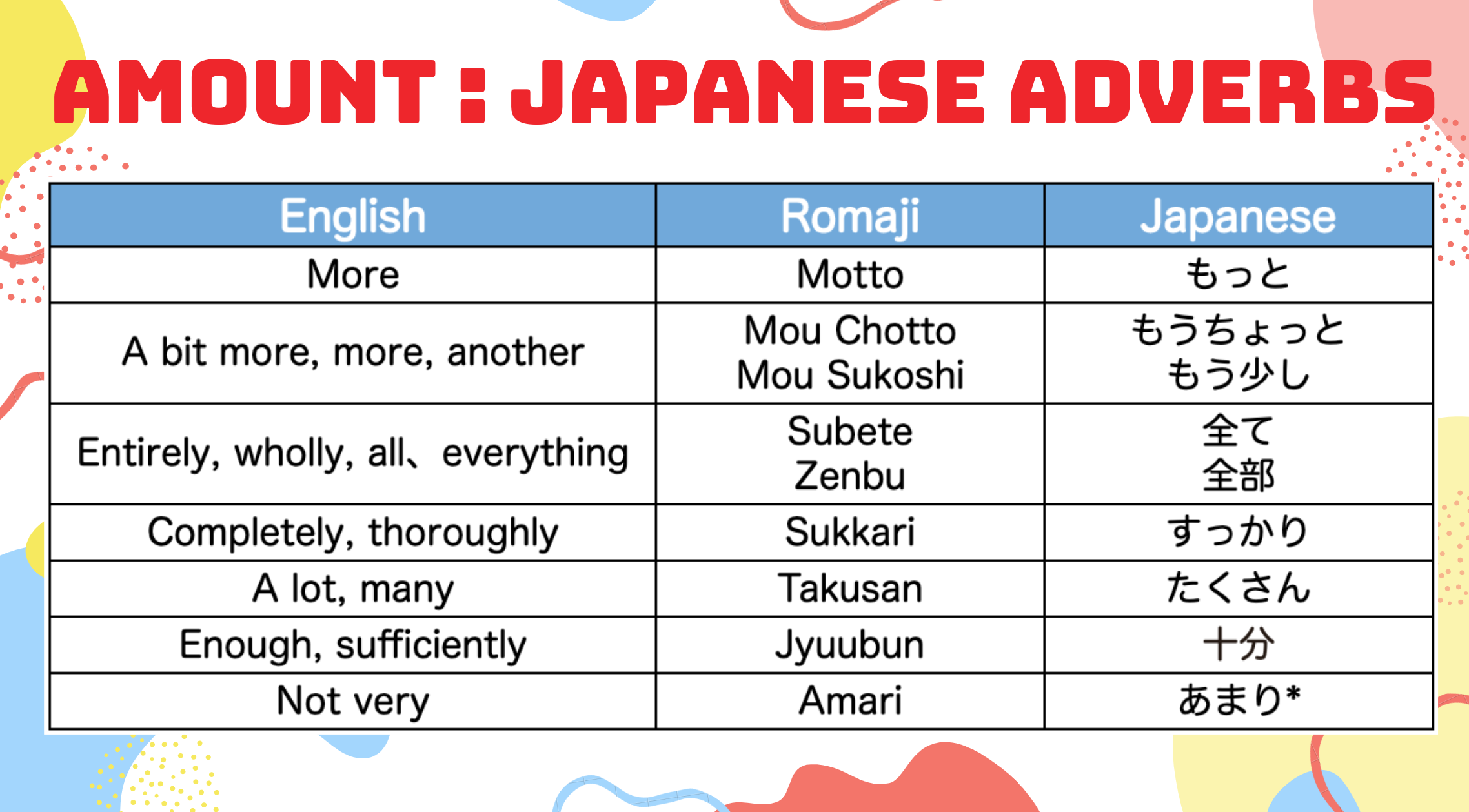
What is an adverb?
An adverb is a word that modifies a verb, adjective, or other adverb. It describes how, when, where, or how much something happens. For example, in the English sentence "I ran quickly," the adverb "quickly" modifies the verb "ran" and tells us how the speaker ran.
Japanese adverbs
Japanese adverbs are similar to English adverbs in that they modify verbs, adjectives, and other adverbs. However, there are some key differences between Japanese and English adverbs.
Formation of Japanese adverbs
Most Japanese adverbs are formed from adjectives by making a few simple changes.
- For i-adjectives, simply replace the "-i" ending with "-ku."
- For na-adjectives, replace the "-na" ending with "-ni."
For example:
i-adjective: 早い (hayai) - early
adverb: 早く (hayaku) - early
na-adjective: きれい (kirei) - pretty
adverb: きれいに (kirei ni) - prettily
There are a few exceptions to this rule, such as the i-adjective "いい" (ii), which becomes the adverb "よく" (yoku).
Placement of Japanese adverbs
Japanese adverbs can be placed anywhere in a sentence before the verb they modify. For example:
- 私は早く起きました。 (Watashi wa hayaku okimashita.) - I woke up early.
- 私はゆっくりと歩きました。 (Watashi wa yukkuri to arukimashita.) - I walked slowly.
- 彼はとても上手に話します。 (Kare wa totemo jouzu ni hanashimasu.) - He speaks very well.
Types of Japanese adverbs
There are many different types of Japanese adverbs, but some of the most common include:
- Time adverbs: いつも (itsumo) - always, よく (yoku) - often, たまに (tamani) - sometimes, 決して (keshite) - never
- Place adverbs: どこ (doko) - where, どこでも (doko demo) - anywhere, どこにも (doko nimo) - nowhere
- Manner adverbs: ゆっくり (yukkuri) - slowly, 早く (hayaku) - quickly, 上手 (jouzu) - well, 下手 (heta) - badly
- Degree adverbs: とても (totemo) - very, 少し (sukoshi) - a little, ほとんど (hotondo) - almost, 全然 (zenzen) - not at all
Examples of Japanese adverbs in sentences
Here are some examples of Japanese adverbs in sentences:
- 私はいつも早く起きます。 (Watashi wa itsumo hayaku okimasu.) - I always wake up early.
- 彼はよく日本に行きます。 (Kare wa yoku Nihon ni ikimasu.) - He often goes to Japan.
- 私はゆっくりと歩きました。 (Watashi wa yukkuri to arukimashita.) - I walked slowly.
- 彼はとても上手 (jouzu) に話します。 (Kare wa totemo jouzu ni hanashimasu.) - He speaks very well.
- 私は少しお酒を飲みました。 (Watashi wa sukoshi osake o nomimashita.) - I drank a little alcohol.
Conclusion
Japanese adverbs are a versatile part of the language that can be used to add detail and nuance to our speech and writing. By learning how to form and use Japanese adverbs correctly, we can communicate more effectively and accurately.
Keyword silo
Adverb
- Japanese adverb
- Types of Japanese adverbs
- Formation of Japanese adverbs
- Placement of Japanese adverbs
- Examples of Japanese adverbs in sentences
HTML format and HTML tags without , and
<h2>What is an adverb?</h2> An adverb is a word that modifies a verb, adjective, or other adverb. It describes how, when, where, or how much something happens. <h2>Japanese adverbs</h2> Japanese adverbs are similar to English adverbs in that they modify verbs, adjectives, and other adverbs. However, there are some key differences between Japanese and English adverbs. <h2>Formation of Japanese adverbs</h2> Most Japanese adverbs are formed from adjectives by making a few simple changes. * For i-adjectives, simply replace the "-i" ending with "-ku." * For na-adjectives, replace the "-na" ending with "-ni." For example: * i-adjective: 早い WebUsing Adverbs in Japanese. Written by Richard Webb | August 2, 2017. Once you have a solid understanding of Japanese sentence structure, one of the easiest ways. WebThere are many words that are not adverbs by themselves but are made into adverbs from other adjectives. This is similar to how "ly" is added to many words in.

The 100 Most Common Japanese Adverbs & How to Use Them - Source: www.japanesepod101.com

Using Adverbs in Japanese - 80/20 Japanese - Source: 8020japanese.com

La guía definitiva para los adverbios japoneses - Source: bondlingo.tv
What Is Adverb In Japanese, What's different about Japanese adverbs of frequency and infrequency, 3.68 MB, 02:41, 34,237, ToKini Andy, 2022-04-28T04:22:57.000000Z, 2, The 100 Most Common Japanese Adverbs & How to Use Them, 800 x 1000, png, verbs adverbs japanesepod101, 3, what-is-adverb-in-japanese
What Is Adverb In Japanese.
Japanese adverbs of frequency and infrequency are a LITTLE different, but quite simple to use when you get the hang of it. In this video, I try to help you understand these Japanese adverbs of frequency.
This grammar point is considered JLPT N5, and is presented in Genki Lesson 3.
Practice this and other grammar points at: tokiniandy.com
DONATE: tokiniandy.com/donate
ToKini Andy MERCH: bit.ly/380JkDc
DISCORD: discord.gg/WP7zYHC
Join this channel to access to perks: bit.ly/2QK6CUc
The 100 Most Common Japanese Adverbs & How to Use Them
What Is Adverb In Japanese, WebUsing Adverbs in Japanese. Written by Richard Webb | August 2, 2017. Once you have a solid understanding of Japanese sentence structure, one of the easiest ways. WebThere are many words that are not adverbs by themselves but are made into adverbs from other adjectives. This is similar to how "ly" is added to many words in.
What's different about Japanese adverbs of frequency and infrequency

Source: Youtube.com
How to change Adjectives into Adverbial usage of adjective in Japanese (Part1)

Source: Youtube.com

0 Comments